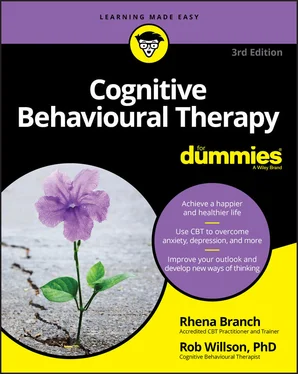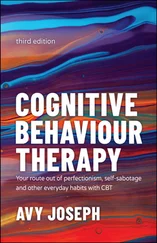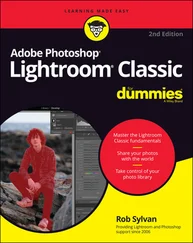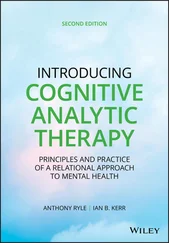 The way you think affects the way you feel. Therefore, changing your unhelpful thoughts is a key to feeling better.
The way you think affects the way you feel. Therefore, changing your unhelpful thoughts is a key to feeling better.
In this chapter, we give you two versions of the ABC form: one to get you started with identifying your triggers, thoughts and feelings and another that takes you right through to developing alternative thoughts so you can feel and act differently in the future.
Getting the hang of the ABC form is often easier if you break down the process into two steps. The first step is to fill out the first three columns ( Activating event, Beliefs and thoughts, Consequences ) of the form, which you can find in the later section “ Stepping Through the ABC Form I”. This gives you a chance to focus on catching your negative automatic thoughts (NATs) on paper and to see the connection between your thoughts and emotions.
 Using the ABC form is great, but if you don’t have one to hand when you feel an upsetting emotion, grab anything you can write on to scribble down your thoughts and feelings. Smartphones are a great method of recording thoughts when you are out and about. You can always transfer your thoughts to a form later. The key thing is to record your thoughts quickly because people sometimes either forget them or tend to censor them later on when their emotions have dulled.
Using the ABC form is great, but if you don’t have one to hand when you feel an upsetting emotion, grab anything you can write on to scribble down your thoughts and feelings. Smartphones are a great method of recording thoughts when you are out and about. You can always transfer your thoughts to a form later. The key thing is to record your thoughts quickly because people sometimes either forget them or tend to censor them later on when their emotions have dulled.
Making the thought–feeling link
A crucial step in CBT is to make the thought–feeling link or B-to-C connection; that is, seeing clearly for yourself the connection between what goes through your mind and your resulting emotions. When you see this connection, it can help you to make much more sense of why to challenge and change your thoughts.
Becoming more objective about your thoughts
One of the biggest advantages of writing down your thoughts is that the process can help you to regard these thoughts simply as hunches, theories and ideas rather than as absolute facts.
 The more negative the meaning you give to an event, the more negative you’ll feel, and the more likely you’ll act in a way that maintains that feeling. Crucially, when you feel negative, you’re more likely to generate negative thoughts. See how easily you can get caught in a vicious circle? Just one of the reasons to take your negative thoughts with a bucket of salt!
The more negative the meaning you give to an event, the more negative you’ll feel, and the more likely you’ll act in a way that maintains that feeling. Crucially, when you feel negative, you’re more likely to generate negative thoughts. See how easily you can get caught in a vicious circle? Just one of the reasons to take your negative thoughts with a bucket of salt!
Stepping Through the ABC Form I
So, time to embark on this major CBT self-help technique using Figure 3-1. The basic process for completing the ABC form is as follows:
1 In the ‘Consequences’ box, point 1, write down the emotion you’re feeling.Therapy’s about becoming emotionally healthier and acting in a more self-helping or productive way. So, when you’re filling out the ABC form, the most important place to start is with the emotion you’re feeling. Emotions and behaviour are consequences (C) of the interaction between the activating event or trigger (A) and the beliefs or meanings (B) in the ABC model of emotion.Examples of emotions you may choose to list in the ‘Consequences’ box include the following:AngerAnxietyDepressionEnvyGuiltHurtJealousyShame Fill out an ABC form when you feel emotionally upset, when you’ve acted in a way that you want to change or when you feel like acting in a way that you wish to change. We give you more information on how to help you understand and identify emotions in Chapter 6.
2 In the ‘Consequences’ box, point 2, write down how you acted or what you felt like doing.Write down how your behaviour changed when you felt your uncomfortable emotion. Examples of the behaviour that people often identify as their actions in this box include these:Avoiding somethingBecoming withdrawn, isolated or inactiveBeing aggressiveBinge-eating or restricting food intakeEscaping from a situationPutting off something (procrastination)Seeking reassuranceTaking alcohol or drugsUsing safety behaviours, such as holding on to something if you feel faint
3 In the ‘Activating Event’ box, write down what triggered your feelings.As we discuss in Chapter 1, the A in ABC stands for activating event or trigger, which is the thing or things that triggered your unhelpful thoughts and feelings. Activating events or triggers to put in this box can include the following:Something happening right nowSomething that occurred in the pastSomething that you’re anticipating happening in the futureSomething in the external world (an object, place or person)Something in your mind (an image or memory)A physical sensation (increased heart rate, headache, feeling tired)Your own emotions or behaviourAn activating event can be pretty much anything. Use your feelings – rather than whether you think the event is important – as a guide to when you should fill out a form. To keep your ABC form brief and accurate, focus on the specific aspect of the activating event that you’re upset about. Use the table of emotions in Chapter 6to help you detect the themes to look out for if you’re unsure about what may have triggered your thoughts and feelings.
4 In the ‘Beliefs’ box, write down your thoughts, attitudes and beliefs.Describe what the event (whatever you’ve put in the ‘Activating Event’ box) meant to you when you felt the emotion (what you’ve written under point 1 in the ‘Consequences’ box).The thoughts, attitudes and beliefs you put in the ‘Beliefs’ box often pop up on reflex. They may be extreme, distorted and unhelpful – but they may seem like facts to you. Some examples of these NATs includeHere I go again, proving that I’m useless!I should’ve known better!Now everyone knows what an idiot I am!This proves that I can’t cope like normal people do!Thoughts are what count, so think of yourself as a detective and set out to capture suspect thoughts. If your thoughts are in the form of a picture, describe the image or what the image means to you – then write them down in the ‘Beliefs’ box. We think not only in words but also in pictures. People who are feeling anxious frequently describe that they see catastrophic images going through their mind. For example, if you fear fainting in a restaurant, you may get an image of yourself on the restaurant floor with staff fussing over you.
5 In the ‘Thinking Error’ box, consider what your thinking errors may be.One of the key ways to become more objective about your thoughts is to identify the thinking errors that may be represented in the thoughts you list in this box. (Have a look at Chapter 2for more details on common thinking errors.)Questions that you might ask yourself in order to identify your thinking errors include the following:Am I jumping to the worst possible conclusion? (Catastrophising)Am I thinking in extreme – all-or-nothing – terms? (Black-and-white thinking)Am I using words like ‘always’ and ‘never’ to draw generalised conclusions from a specific event? (Overgeneralising)Am I predicting the future instead of waiting to see what happens? (Fortune-telling)Am I jumping to conclusions about what other people are thinking of me? (Mind-reading)Am I focusing on the negative and overlooking the positive? (Mental filtering)Am I discounting positive information or twisting a positive into a negative? (Disqualifying the positive)Am I globally putting myself down as a failure, worthless or useless? (Labelling)Am I listening too much to my negative gut feelings instead of looking at the objective facts? (Emotional reasoning)Am I taking an event or someone’s behaviour too personally or blaming myself and overlooking other factors? (Personalising)Am I using words like ‘should’, ‘must’, ‘ought’ and ‘have to’ in order to make rigid rules about myself, the world or other people? (Demanding)Am I telling myself that something is too difficult or unbearable or that ‘I can’t stand it’ when actually it’s hard to bear but it is bearable and worth tolerating? (Having a low frustration tolerance)
Читать дальше

 The way you think affects the way you feel. Therefore, changing your unhelpful thoughts is a key to feeling better.
The way you think affects the way you feel. Therefore, changing your unhelpful thoughts is a key to feeling better. Using the ABC form is great, but if you don’t have one to hand when you feel an upsetting emotion, grab anything you can write on to scribble down your thoughts and feelings. Smartphones are a great method of recording thoughts when you are out and about. You can always transfer your thoughts to a form later. The key thing is to record your thoughts quickly because people sometimes either forget them or tend to censor them later on when their emotions have dulled.
Using the ABC form is great, but if you don’t have one to hand when you feel an upsetting emotion, grab anything you can write on to scribble down your thoughts and feelings. Smartphones are a great method of recording thoughts when you are out and about. You can always transfer your thoughts to a form later. The key thing is to record your thoughts quickly because people sometimes either forget them or tend to censor them later on when their emotions have dulled.










